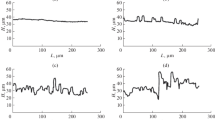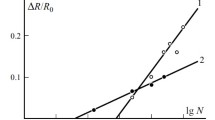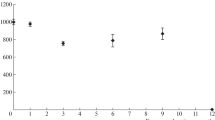Abstract
The review analyzes the influence of the significant factors of action of various climatic zones on the deformation–strength characteristics of polymer composite materials. The generalized index of aging is shown to depend on the exposure conditions and time, the physicochemical transformations in materials, temperature, the nature of reinforcing filler, the presence of sorbed moisture, and methodological measurement errors.




Similar content being viewed by others
REFERENCES
E. N. Kablov, “Materials and chemical technologies for aviation engineering,” Vestn. Ross. Akad. Nauk 82 (6), 520–530 (2012).
I. I. Sokolov and A. E. Raskutin, “Next-generation carbon and glass plastics,” Trudy VIAM, No. 4, Art. 09, (2013). http://www.viam-works.ru. Cited May 15, 2019.
A. Baker, S. Dutton, and D. Kelly, Composite Materials for Aircraft Structures, 2nd ed. (Reston, 2004).
E. N. Kablov, O. V. Startsev, A. S. Krotov, and V. N. Kirillov, Climatic aging of aviation polymer composite materials: I. Aging mechanisms, Deform. Razrush. Mater., No. 11, 40–46 (2010).
E. N. Kablov, O. V. Startsev, A. S. Krotov, and V. N. Kirillov, Climatic aging of aviation polymer composite materials: II. Relaxation of the initial structural nonequilibrium and through-thickness gradient of properties, Deform. Razrush. Mater., No. 12, 40–46 (2010).
E. N. Kablov, O. V. Startsev, A. S. Krotov, and V. N. Kirillov, Climatic aging of aviation polymer composite materials: III. Significant factors of aging, Deform. Razrush. Mater., No. 1, 34–40 (2011).
E. N. Kablov, “Innovative solutions of FGUP VIAM GNTs RF for ‘Strategic Directions of Designing Materials and Technologies of Their Processing up to 2030’,” Aviats. Mater. Tekhnol., No. 1(34), 3–33 (2015). https://doi.org/10.18577/2071-9140-2015-0-1-3-33
D. V. Grashchenkov, E. V. Nikolaev, V. A. Efimov, and V. N. Kirillov, “Moscow climate testing center FGUP VIAM—regional center for testing materials in a representative zone of temperate climate,” in Proceedings of 9th Conference Gidroaviasalon-2012 (Izd. TsAGI, Moscow, 2012), Part 2, pp. 202–208.
E. N. Kablov, V. N. Kirillov, A. D. Zhirnov, O. V. Startsev, and Yu. M. Vapirov, “Centers for climatic tests of aviation PCM”, Aviats. Prom., No. 4, 36–46 (2009).
E. N. Kablov, O. V. Startsev, I. M. Medvedev, and S. V. Panin, “Corrosive aggressiveness of the coastal atmosphere. Part 1. Influence factors (review),” Korroziya: Mater. Zashchita, No. 12, 6–18 (2013).
E. N. Kablov, O. V. Startsev, and I. M. Medvedev, “Corrosive aggressiveness of the coastal atmosphere. Part 2. New approaches to estimating the corrosivity of coastal atmosphere,” Korroziya: Mater. Zashchita, No. 12, 1–15 (2013).
Ageing of Composites, Ed. by R. Martin (Woodhead Publishing Ltd., Cambridge, 2008).
W. Tian and J. Hodgkin, “Long-term aging in a commercial aerospace composite sample: chemical and physical changes,” J. Appl. Polym. Sci. 115 (5), 2981–2985 (2010).
A. Kudo and G. Ben, “Estimation of weatherability flexural properties for CFRP subjected to long-term outdoor exposure,” in Proceedings of 18th International Conference on Composite Materials (2011), pp. W27-3–W27-9.
K. Mezghani, “Long term environmental effects on physical properties of vinylester composite pipes,” Polymer Testing 3 (1), 76–82 (2012).
I. Nishizaki, H. Sakurada, and T. Tomiyama, “Durability of pultruded GFPR through ten-year outdoor exposure test,” Polymers 7, 2494–2503 (2015).
I. Sasaki and I. Nishizaki, “Tensile load relaxation of FRP cable system during long-term exposure tests,” in Proceedings of 6th International Conference on FRP Composites in Civil Engineering (CICE 2012) (Rome,2012), pp. 1–8.
J. M. Sousa, J. R. Correia, and S. Cabral-Fonseca, “Durability of glass fibre reinforced polymer pultruded profiles: comparison between QUV accelerated exposure and natural weathering in a mediterranean climate,” Exp. Technique 40 (1), 207–219 (2013).
Long-Term Durability of Polymeric Matrix Composites, Ed. by K. V. Pochiraju, G. A. Schoeppner, and G. P. Tandon (Springer, 2012).
Service Life Prediction of Polymers and Plastics Exposed to Outdoor Weathering, Ed. by C. C. White, K. M. White, and J. E. Pickett (Elsevier, 2017).
L. Belec, T. H. Nguyen, D. L. Nguyen, and J. F. Chailan, “Comparative effects of humid tropical weathering and artificial ageing on a model composite properties from nano- to macro-scale,” Composites: A 68 (1), 235–241 (2015).
P. Böer, L. Holliday, and T. H.-K. Kang, “Interaction of environmental factors on fiber-reinforced polymer composites and their inspection and maintenance: a review,” Construct. Build. Mater. 50, 209–218 (2014).
G. Carra and V. Carvelli, “Ageing of pultruded glass fibre reinforced polymer composites exposed to combined environmental agents,” Comp. Struct. 108, 1019–1026 (2014).
T. Keller, N. A. Theodorou, A. P. Vissilopoulos, and J. de Castro, “Effect of natural weathering on durability of pultruded glass fiber-reinforced bridge and building structures,” J. Comp. Constr. 20 (1), 04015025 (2015).
A. Komorek, P. Przybylek, and W. Kucharczyk, “Effect of sea water and natural ageing on residual strength of epoxy laminates, reinforced with glass and carbon woven fabrics,” Adv. Mater. Sci. Eng. 2016, Article ID 3754912 (2016).
D. Kotnarowska, “Destruction of epoxy coatings under the influence of climatic factors,” Solid State Phen. 199, 581–586 (2013).
V. N. Kirillov, O. V. Startsev, and V. A. Efimov, “Climatic resistance and damage of polymer composite materials, problems and solutions,” Aviats. Mater. Tekhn., No. S, 412–423 (2012).
V. A. Efimov, A. K. Shvedkova, T. G. Korenkova, and V. N. Kirillov, “Study of polymer structural materials under the effect of climatic factors and loads under laboratory and field conditions,” Trudy VIAM, No. 1, 1–7 (2013).
E. V. Nikolaev, S. L. Barbot’ko, N. P. Andreeva, and M. R. Pavlov, “Comprehensive study of the effect of climatic and operational factors on the next generation of epoxy binder and polymer composite materials based on it. Part 1. Study of the effect of sorbed moisture on an epoxy matrix and the carbon fiber based on it,” Trudy VIAM, No. 12, 1–11 (2015).
E. V. Nikolaev, S. L. Barbot’ko, N. P. Andreeva, and M. R. Pavlov, “Comprehensive study of the effect of climatic and operational factors on the next generation of epoxy binder and polymer composite materials based on it. Part 2. Choice of conditions of artificial aging of polymer composite materials based on epoxy matrix,” Trudy VIAM, No. 1, 1–9 (2016).
E. V. Nikolaev, S. L. Barbot’ko, N. P. Andreeva, and M. R. Pavlov, “Comprehensive study of the effect of climatic and operational factors on the next generation of epoxy binder and polymer composite materials based on it. Part 3. Calculation of the activation energy and the heat resource of polymeric polymer composites based on epoxy matrix,” Trudy VIAM, No. 5, 1–11 (2016).
E. V. Nikolaev, S. L. Barbot’ko, N. P. Andreeva, and M. R. Pavlov, “Comprehensive study of the effect of climatic and operational factors on the next generation of epoxy binder and polymer composite materials based on it. Part 4. Full-scale climatic tests of polymer composite materials,” Trudy VIAM, No. 6, 1–10 (2016).
A. E. Sorokin, E. Ya. Bader, T. F. Izotova, E. V. Nikolaev, and A. K. Shvedkova, “Investigation of the properties of carbon fiber on a polyphenylene sulfide binder after accelerated and full-scale climatic tests,” Aviats. Mater. Tekhn., No. 3 (42), 66–72 (2016).
V. A. Efimov, V. N. Kirillov, O. A. Dobryanskaya, E. V. Nikolaev, and A. K. Shvedkova, “Methodological problems of conducting full-scale climatic tests of polymer composite materials,” Aviats. Mater. Tekhn., No. 4, 25–31 (2010).
V. N. Kirillov, V. A. Efimov, S. L. Barbot’ko, and E. V. Nikolaev, “Methodological features of conducting and processing the results of climatic tests of polymer composite materials,” Plastich. Massy, No. 1, 37–41 (2013).
E. N. Kablov, D. V. Grashchenkov, V. S. Erasov, I. E. Anchevskii, V. V. Il’in, and R. S. Walter, “Test bench for large-sized structures made of PCM at GCCI climate station,” in Proceedings of 9th Conference Gidroaviasalon-2012 (Izd. TsAGI, Moscow, 2012), pp. 122–123.
A. N. Lutsenko, A. V. Slavin, V. S. Erasov, and K. K. Khvatskii, “Strength testing and research of aviation materials,” Aviats. Mater. Tekhn., No. S, 527–546. https://doi.org/10.18577/2071-9140-2017-0-S-527-546
L. T. Startseva, S. V. Panin, O. V. Startsev, and A. S. Krotov, “Moisture diffusion in glass-fiber-reinforced plastics after their climatic ageing,” Dokl. Phys. Chem. 456 (1), 77–81 (2014).
E. N. Kablov, O. V. Startsev, and S. V. Panin, “Moisture transfer in carbon fiber with a degraded surface,” Dokl. Akad. Nauk 461 (4), 433–436 (2015).
A. P. Petrova, “Properties of adhesives and materials based on them in the Arctic. Review,” Klei. Germetiki. Tekhn., No. 4, 32–42 (2017).
V. A. Efimov, V. N. Kirillov, A. K. Shvedkova, and E. V. Nikolaev, “Effect of exposure conditions on the strength properties of polymer composite materials, in Proceedings of 8th Conference Gidroaviasalon-2010 (Izd. TsAGI, Moscow, 2010), Part 2, pp. 171–175.
E. N. Kablov and V. O. Startsev, “System analysis of the influence of climate on the mechanical properties of polymer composite materials according to domestic and foreign sources (review),” Aviats. Mater. Tekhn., No. 2, 47–58 (2018).
V. N. Kirillov, V. A. Efimov, E. V. Nikolaev, A. K. Shvedkova, T. G. Korenkova, and I. S. Deev, “On the problem of the methodology for conducting full-scale climatic tests of polymer composite materials,” in Proceedings of 8th Conference Gidroaviasalon-2010 (Izd. TsAGI, Moscow, 2010), Part 2, pp. 102–106.
V. N. Kirillov, V. A. Efimov, O. A. Dobryanskaya, E. A. Drozd, M. G. Kurs, and Yu. M. Vapirov, “Study of the atmospheric resistance of polymer composite materials in the coastal atmosphere of a warm, humid and moderately warm climate,” in Proceedings of 8th Conference Gidroaviasalon-2010 (Izd. TsAGI, Moscow, 2010), Part 2, pp. 84–90.
S. A. Awad, C. M. Fellows, and S. Saeed Mahini, “A comparative study of accelerated weathering of epoxy resins based on DGEBA and HDGEBA,” J. Polym. Res. 25 (4), 103 (2018).
V. O. Startsev, M. P. Lebedev, A. S. Frolov, and T. A. Nizina, “Relationship between the deformability and fractographic characteristics of fracture surfaces of epoxy polymers,” Dokl. Phys. Chem. 476 (1), 149–152 (2017).
V. O. Startsev, M. P. Lebedev, K. A. Khrulev, M. V. Molokov, A. S. Frolov, and T. A. Nizina, “Effect of outdoor exposure on the moisture diffusion and mechanical properties of epoxy polymers,” Polymer Testing 65, 281–296 (2018).
G. M. Odegard and A. Bandyopadhyay, “Physical aging of epoxy polymers and their composites,” J. Polym. Sci.: B 49 (24), 1695–1716 (2011).
O. V. Startsev, L. I. Anikhovskaya, A. A. Litvinov, and A. S. Krotov, “Increasing the reliability of predicting the properties of polymer composites in hydrothermal aging,” Dokl. Chem. 428 (1), 233–237 (2009).
V. O. Startsev, “Across-the-thickness gradient of the interlaminar shear strength of a CFRP after its long-term exposure to a marine climate,” Mech. Comp. Mater. 52 (2), 171–176 (2016).
S. V. Panin, V. O. Startsev, M. G. Course, and E. A. Varchenko, “Development of climatic testing methods of materials for mechanical engineering and construction in GTsKI VIAM,” in All Materials.Encyclopedic Handbook (2016), Vol. 10, pp. 50–61.
V. O. Startsev, K. E. Kutsevich, K. A. Khrulev, and M. V. Molokov, “Prediction of the surface temperature of composite materials based on adhesive prepregs during exposure under climatic conditions,” Klei. Germetiki. Tekhnologii, No. 9, 24–31 (2017).
E. N. Kablov, V. O. Startsev, and A. A. Inozemtsev, “Moisture saturation of structurally similar elements from polymer composite materials under open climatic conditions with superimposed thermal cycles,” Aviats. Mater. Tekhn., No. 2, 56–68 (2017). https://doi.org/10.18577/2071-9140-2017-0-2-56-68
V. O. Startsev, M. P. Lebedev, M. V. Molokov, and D. R. Nizin, “Gradient of dynamic mechanical characteristics across the epoxy polymer thickness during full-scale exposure,” Klei. Germetiki. Tekhnologii, No. 6, 31–40 (2019).
V. O. Startsev, I. N. Gulyaev, K. A. Pavlovskii, and M. Yu. Ulkin, “Effect of the scale factor on the moisture transfer in carbon fiber,” Materialoved., No. 8, 39–46 (2017).
O. V. Startsev, E. N. Kablov, and A. Yu. Makhonkov, “Laws of the α transition of the epoxy binders of composite materials according to dynamic mechanical analysis,” Vestn. MGTU, Ser. Mashinostr., No. S2, 104–113 (2011).
V. N. Kirillov, V. A. Efimov, A. K. Shvedkova, V. N. Aleksashin, A. V. Zuev, and E. V. Nikolaev, “Study of the influence of climatic factors and mechanical loading on the structure and mechanical properties of carbon fiber reinforced plastic 11TR,” in Proceedings of 8th Conference Gidroaviasalon-2010 (Izd. TsAGI, Moscow, 2010), Part 2, pp. 111–115.
O. V. Startsev, V. P. Meletov, B. V. Perov, and G. P. Mashinskaya, “Studies of the mechanism of aging of organic textolite in a subtropical climate,” Mekh. Komposit. Mater., No. 3, 462–467 (1986).
Aviation Materials: A Handbook.Vol. 13.Climatic and Microbiological Resistance of Nonmetallic Materials, ed. by E. N. Kablov (VIAM, Moscow, 2015), pp. 15–128.
N. S. Perov, V. O. Startsev, E. Yu. Chutskova, A. I. Gulyaev, and D. V. Abramov, “Properties of carbon fiber based on polycyanurate binder after exposure in various natural and artificial media,” Materialoved., No. 2, 3–9 (2017).
A. B. Laptev, S. L. Barbot’ko, and E. V. Nikolaev, “The main directions of research on the persistence of material properties under the influence of climatic and operational factors,” Aviats. Mater. Tekhn., No. S., 547–561 (2017).
A. B. Laptev, E. V. Nikolaev, A. A. Skirta, and D. A. Laptev, “Method for assessing the state of materials in the process of climatic aging,” Aviakosmich. Priborostr., No. 11, 20–29 (2016).
M. R. Pavlov, E. V. Nikolaev, N. P. Andreeva, and S. L. Barbot’ko, “On the problem of estimating the resistance of polymeric materials to solar radiation (review),” Trudy VIAM, No. 7 (43), Art. 11 (2016). https://doi.org/10.18577/2307-6046-2016-0-7-11-11
A. K. Shvedkova, A. P. Petrova, and V. M. Buznik, “Climate resistance of composite materials based on adhesive prepregs under Arctic conditions,” Polym. Sci. Ser. D 9 (2), 165–171 (2016).
V. N. Kirillov, Yu. M. Vapirov, and E. A. Drozd, “Atmospheric stability of polymer composite materials in the atmosphere of warm, humid and moderately warm climate,” Aviats. Mater. Tekhn., No. 4, 31–38 (2012).
E. N. Kablov, O. V. Startsev, and V. N. Kirillov, “Climatic aging of aviation polymer composite materials,” in Proceedings of V Eurasian Symposium on the Problems of Strength of Materials and Machines for Cold Climate Regions (IFTPPS SO RAN, Yakutsk, 2010), pp. 167–177.
O. V. Startsev, V. N. Kirillov, and A. Ya. Rudolf, “New opportunities in studying the climatic aging of polymer composite materials,” in Proceedings of 8th Conference Gidroaviasalon-2010 (Izd. TsAGI, Moscow, 2010), Part 2, pp. 97–101.
V. N. Bulmanis and O. V. Startsev, Prediction of Changes in the Strength of Polymer Fiber Composites as a Result of Climatic Action (Yakutsk Center, Siberian Branch, USSR Academy of Sciences; Institute of Physical and Technical Problems of the North, SO RAN, Yakutsk, 1988).
Funding
This work was supported by the Russian Foundation for Basic Research, project no. 18-29-18029.
Author information
Authors and Affiliations
Corresponding author
Additional information
Translated by K. Shakhlevich
Rights and permissions
About this article
Cite this article
Kablov, E.N., Startsev, V.O. Climatic Aging of Aviation Polymer Composite Materials: I. Influence of Significant Factors. Russ. Metall. 2020, 364–372 (2020). https://doi.org/10.1134/S0036029520040102
Received:
Revised:
Accepted:
Published:
Issue Date:
DOI: https://doi.org/10.1134/S0036029520040102




